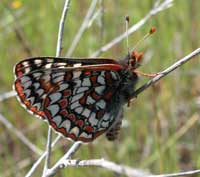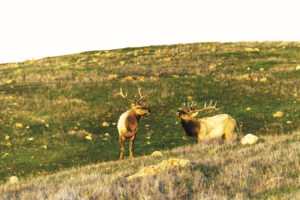Contrary to common notions of autumn as a season of dying back, our fall rains often herald new beginnings. That’s especially true this fall at Edgewood County Park and Natural Preserve in Redwood City. For the first time since 2002, caterpillars of the once-abundant but now rare bay checkerspot butterfly (Euphydryas editha bayensis) will emerge from summer dormancy to feed on the new growth of their host plants.
This lovely lepidopteran was reintroduced here last spring with individuals gathered from the species’ last stand at Coyote Ridge, south of San Jose. The efforts to save this butterfly have under-scored how complex habitat protection can be. “We can’t just set aside land, fence it off, leave it alone, and hope everything will work out,” says Stuart B. Weiss, consulting ecologist with Creekside Center for Earth Observation. “That doesn’t work anymore.”
The bay checkerspot once inhabited all five South Bay counties, but urbanization forced it onto ever-shrinking and fragmented refuges. Although it was federally listed as threatened in 1987, legal protection didn’t stop the events that extinguished Edgewood’s population. Research at Coyote Ridge laid the foundation for understanding what happened to Edgewood’s butterflies—and how to bring them back.
Bay checkerspots thrive on serpentine grasslands, where native plants persist on unusual soils lacking nitrogen and other nutrients. Adult butterflies nectar on several species, but the caterpillars depend on California plantain (Plantago erecta).
- The first adult—dubbed Edward the First by folks working on thebutterfly reintroduction—emerges after last spring’s reintroduction.Photo by Stuart B. Weiss, Creekside Center for Earth Observation.
Checkerspots still prosper at Coyote Ridge partly because so much serpentine habitat remains-thousands of acres, most grazed by cattle. The striking topography also supports the butterfly: Deep valleys cleave the eastern slopes of the north-south-running ridge. Those valleys offer both cooler north-facing slopes and warmer south-facing slopes, which, taken together, provide a buffer against bad weather. Cooler slopes favor survival in hot, dry years. In cool, wet years, the warmer slopes provide refuge. Weiss has even calculated the minimum amount of season-stretching topographical diversity the butterfly needs.
He has also explained how grazing helps maintain checkerspot habitat. Serpentine soils usually thwart nonnative grasses such as Italian ryegrass (Lolium multiflorum), while allowing native plants adapted to the nitrogen-poor soil to survive. But nitrogen from air pollution, such as the car exhaust from Interstate 280, which passes right by Edgewood, fertilizes the soil, foiling the natives’ adaptive advantage and encouraging ryegrass growth. That led to the disappearance of the checkerspot from Edgewood, a process Weiss dubs “drive-by extinction.” Yet at Coyote Ridge, where cattle still graze, ryegrass doesn’t overrun plantain, because cattle prefer to eat ryegrass. So, plantains and bay checkerspots have flourished, despite the proximity of Highway 101.
Fortunately, if you can’t send in the cows, well-timed mowing will do, and the benefits linger at least four years. Last spring, nearly 20 acres of restored grasslands hosted a “homecoming” for 1,000 caterpillars gathered from Coyote Ridge. “I know of very few reintroduction events on this scale,” says Mace Vaughan, conservation director with the Xerces Society for Invertebrate Conservation. “It’s pretty exciting.”
In addition to sharing this “lepidopterrific” news with park visitors, Edge-wood’s very active volunteer corps helped Weiss count butterflies, both for altruistic reasons and for the pollen-toed thrill of seeing abundant wildflowers in restored habitat. They’ll head out in February for the ultimate determination of success—the caterpillar count.
For now, your best chances of seeing bay checkerspots remain at Coyote Ridge, where a new docent program began this year, a joint project of the Silicon Valley Land Conservancy, the California Native Plant Society, and the Santa Clara County Open Space Authority. During spring wildflower—and butterfly—season, docents lead walks to the Kirby Canyon Butterfly Trust, a small portion of the roughly 1,200 acres of serpentine habitat protected here in a complicated mosaic of parcels.
“About 7,800 acres remain to be protected, so there’s a lot of work to do,” says Craige Edgerton, director of the Silicon Valley Land Conservancy—work for scientists, land conservancies, government agencies, and the public. He says the “protection web,” like nature’s web, needs everyone pulling together.
The bay checkerspot’s devoted following is doing just that.
For details on springtime walks: The Silicon Valley Land Conservancy or (408)260-3044 and Friends of Edgewood or (866)463-3439.

.jpg)




